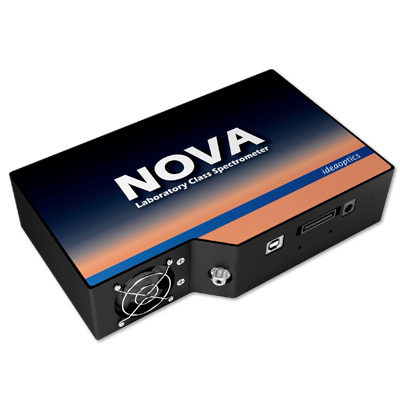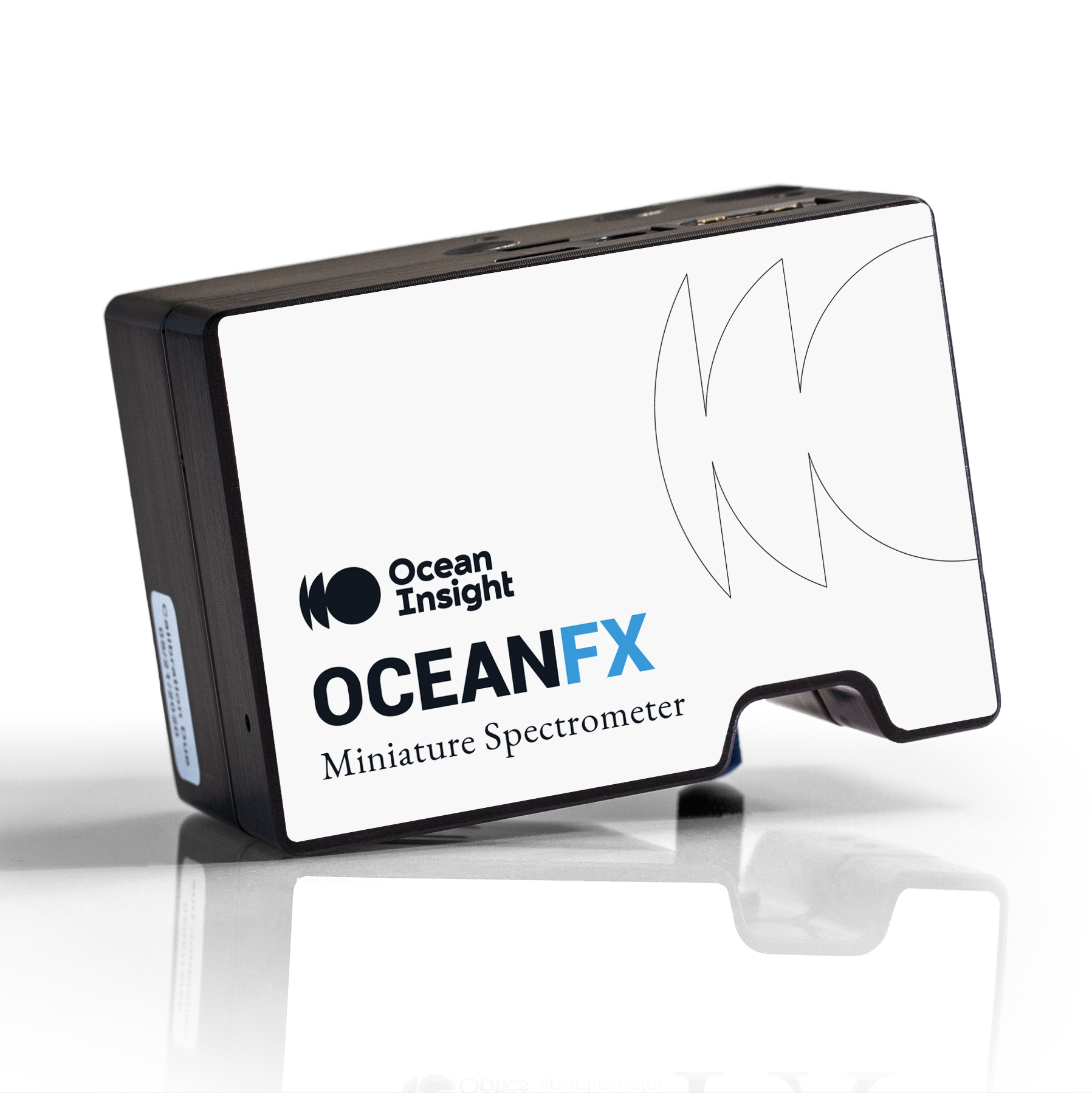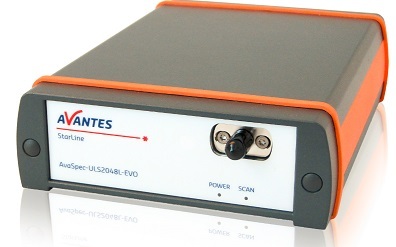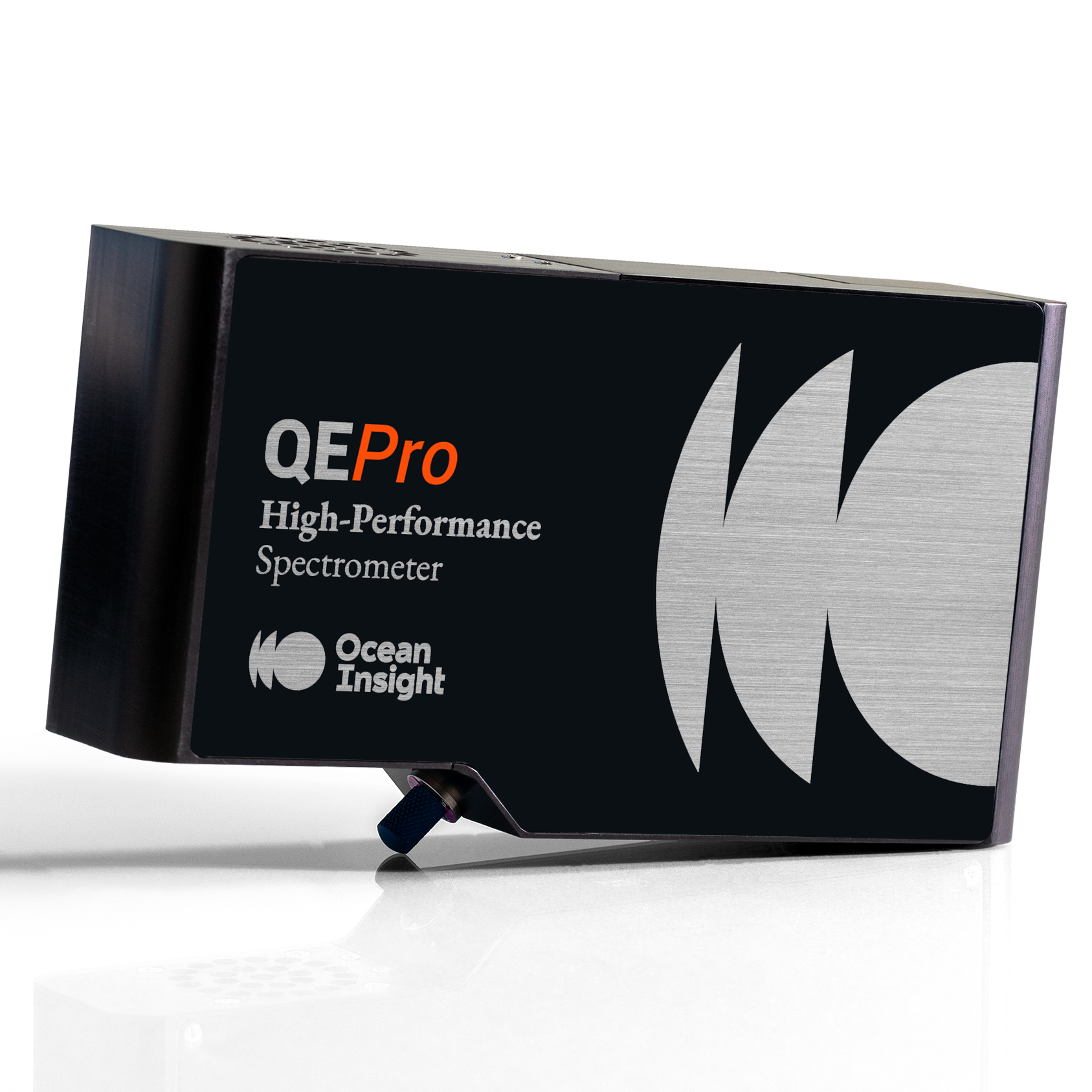
方案详情
文
宝石是一个价值数十亿美元的产业,包括中国和印度在内的一些国家不断增长的市场促进了它的繁荣发展。市场的需求也在不断增加,预测者预计其价格会上涨,导致市场上的仿冒品大量流出。一些技术可帮助鉴别这些仿冒品,如拉曼光谱法和相关技术可轻松、快速有效地从人造石中无损地鉴别出许多天然石材。同时,它是一种无需制样的技术。
方案详情

ApplicationNote KEYWORDS GemstonesCounterfeitingNondestructiveanalysis TECHNIQUES Raman FluorescencePhotoluminescence APPLICATIONS Gemstoneauthentication Material identification Gemstone Analysisand Authentication How Spectroscopy HelpsIdentify Counterfeits Gemstones are a multibillion-dollar industry, with growingmarkets in countries including China and India contributingto the boom. As demand increases, forecasters anticipatethat prices will rise - and boost the prevalence of counterfeitgemstones as a result. There are technical tools to help thwart the counterfeiters.Raman spectroscopy and related techniques are effective forquickly and easily discriminating many natural from artificialstones, nondestructively and with no sample preparation. Background Among the most commonly counterfeited and substitutedgems are stones such as diamonds, emerald, ruby and jade,and substances such as amber, coral and pearl. Yet all haveunique spectral characteristics that can be identified withpowerful spectral instrumentation and proven methodologies.For example, Raman spectroscopy can explore the molecularstructure of the gemstone. The spectral fingerprints provid- ed by Raman spectroscopy contain peaks thatcan be tied to a gemstone's chemical structure,as well as the trace minerals and inclusions thatgive stones such as emerald and ruby their dis-tinctive hues (Figure 1). Figure 1. Raman spectroscopy is an excellent tool for gemstone analysis. In thisgraph, the intensity has been shifted to facilitate comparison of spectral shapedifferences. Luminescence induced byahigh-power,short-wavelength light source offers additionalinformation that can be used to authenticate andto detect various gemstone treatments. Naturaland synthetic emeralds, for example, have thesame chemical structure and therefore identicalRaman spectra. Both get their deep green colorfrom the presence of chromium and vanadiumion impurities, but slight differences in the con-centrations and presence of other metal impu-rities affect the intensity and wavelength of thechromium photoluminescence bands, allowingsynthetic emeralds to be distinguished from nat-ural types. There's more. Raman and photoluminescencemeasurements performed concurrently using a532 nm excitation laser can allow gemologists todetermine whether coral and freshwater pearls have been dyed to enhance their natural color,which artificially increases their value. AuthenticatingNatural Diamonds Figure 2. Naturally clear diamonds exhibit photoluminescence peaks from 530-600 nm. HPHT treatment removes most of these peaks, leaving only nitrogen-va-cancy peaks at 576 nm and 637 nm in some samples. Synthetically grown and artificially treated dia-monds often are sold as natural diamonds, withimproved fabrication and processing methodsmaking authentication more difficult. A systemdeveloped by an Ocean Insight solutions partnerland powered by one of our high-sensitivity Ra-man spectrometers is capable of measuring bothRaman signal and photoluminescence concur-rently, providing comprehensive analysis of nat-ural diamonds and their simulants. Here are twoexamples: · Natural diamond has a strong Raman peakatt 1332 cm-1, while diamonds produced usingchemical vapor deposition (CVD) processes haveno such peak -- a feature that allows near-instantauthentication. ·Less desirable brown and gray diamonds are annealed to near-colorless using high-pressure,high-temperature (HPHT) treatments.ThoughHPHT-treated diamonds cost up to 65% less thanauthentic diamonds and may be sold as natu-ral stones, they lack several photoluminescencepeaks typically seen in the Raman/photolumines-cence spectrum of natural diamonds (Figure 2). Zircon is another natural gemstone that can beheated to make it colorless and more closely re-semble diamond. (Zircon should not be confusedwith cubic zirconia, an inexpensive syntheticgemstone that's very popular as a diamond simu-lant.) Raman analysis of zircon and diamond canbe applied to reveal different spectral characteris-tics for each (Figure 3). Figure 3. Distinct spectral differences can be observed in comparing diamond andzircon samples. Identifying Amber Specimens Though amber is found in several regions in theworld, Chiapas amber, named for the region inMexico where it's found, is prized for its trans-parency and stunning colors, varying from honeyto green, blue, violet and deep red. Harder than amber from the Baltic and other regions, Chiapasamber is ideal for jewelry and carvings. This fos-silized resin took millions of years to form, yetis sometimes imitated using artificial resins andglasses. In a 2014 paper, investigators at the Centro deInvestigaciones en Optica, A. C. in León, Mexicocompared false amber to specimens from theBaltic and Chiapas regions, observing fluores-cence excited with a tunable Argon-ion laser at457 nm, 488 nm, 514 nm and multi-line outputs2.The fluorescence was detected with an OceanInsight USB4000 spectrometer for the Baltic andChiapas amber superimposed with the scatteredlaser light, but no fluorescence was seen for thefalse amber (Figure 4). Even comparing fluores-cence spectra for the true amber, a slight shift inthe emission peak could be seen for the Chiapasamber at ~525 nm as compared with the Balticamber at ~535 nm. The researchers found thatRaman spectroscopy also distinguished falsefrom true amber, and more clearly identified am-ber from different regions. Figure 4. Unlike naturally occurring amber, false amber has no fluorescenceresponse. Additional investigation also reveals differences in Chiapas and Balticamber samples. Determining the Color of Pearls Cultured freshwater pearls get their natural col-ors from organic pigments called polyenes, whichexhibit enhanced Raman scattering. Dyes can beused to produce colored pearls to simulate rarenatural specimens, making visual identificationalone very challenging. Spectroscopy, however, tells a different story. Cultured freshwater pearls in their natural statehave a broad, consistently shaped luminescencepeak punctuated by Raman peaks attributableto aragonite (a form of calcium carbonate) andpolyene compounds (Figure 5). Dyed culturedfreshwater pearls, in clear contrast, can exhibit avariety of luminescence curves due to the dye-ing agents (Figure 6). While it may not be pos-sible to identify the dyeing agent, photolumines-cence-enhanced Raman spectroscopy makesit very easy to identify the absence or presenceof dyes and thus validate the value of culturedfreshwater pearls. Figure 5. Natural freshwater pearls have characteristic Raman peaks associatedwith aragonite, a carbonate mineral. Figure 6. Dyed pearls produce various luminescence curves. Identifying Dyed Corals Coral comes in a variety of shades, from light pinkto deep red. While coral can be positively identi-fied by looking under a microscope for the char-acteristic grooves used to transport nutrients, thetraditional test for dyed coral requires swabbingthe specimen with acetone, risking damage tothe sample. Figure 7. Dyed coral exhibits a broad luminescence curve compared with the morepronounced Raman peaks associated with natural corals. Naturally colored coral has distinctive Ramanpeaks on a characteristic photoluminescencebackground. These peaks indicate forms of calci-um carbonate, as well as the polyacetylenes and carotenoids that imbue coral with such beautifulcolor. When dyed coral is subjected to the samemeasurement, a much broader photolumines-cence curve is seen (Figure 7), both centered ata different wavelength and lacking Raman peaks.Identifying dyed corals from natural may seemlike an esoteric pursuit, until one realizes thatsome dyed corals are protected species that havebeen harvested illegally and fraudulently market-ed as permitted for legal trade. Classifying Emeralds Figure 8. Subtle differences between authentic and synthetic emeralds are re-vealed in spectral analysis. Emerald owes its stunning deep green color tothe presence of chromium (Cr3t) and vanadium(V3t) ions in a beryl crystal matrix. Both naturaland synthetic emeralds have the same chem-ical structure, making it difficult to discriminatethe two. While emeralds exhibit no distinctiveRaman peaks, they do show two Cr3+ photolumi-nescence bands, the exact positions of which areinfluenced by the presence of other impurities likemagnesium, titanium and zinc in the beryl struc-ture. This allows synthetic emerald to be distin-guished from the two natural types of emerald,schist and non-schist (Figure 8). Synthetic emerald also tends to have higherchromium ion concentrations than natural emer-ald, which results in stronger photoluminescencepeaks. Even when a natural emerald owes itscolor primarily to vanadium ions, the chromiumion concentration is still high enough to exhibitphotoluminescence, making this a very effectivemethod to authenticate natural emeralds. Applying Spectral Analysis toOther Gemstones Those responsible for identifying and authenti-cating gemstones need robust equipment basedon sound science. Compact spectroscopy sys-tems fill that role well on many levels, as instru-ments can be readily optimized to detect spectralpeaks and patterns correlated to natural gem-stones, synthetics and counterfeits (Figure 9). Figure 9. The word "jade" describes the minerals jadeite ornephrite. Raman spec-troscopy helps to reveals differences in jade types and point of origin. The power of spectroscopy exceeds all our sens-es, for it analyzes the very nature of materials.Ocean Insight modular spectroscopy systems offer many ways to counter fraud, whether it's inthe lab or in the field, with instrumentation con-figured as a single setup for research or a customsolution integrated into another device. Acknowledgements: Figures 2 and 5-8 are cour-tesy of MAGILABS. References 1. GemmoRaman-532 from Magilabs Oy (Ltd) (gemmoraman.com). 2. Lopez-Morales, Guadalupe, R. Espinosa-Luna, and ClaudioFrausto-Reyes. "Optical characterization of amber of Chiapas."Revista mexicana de fisica60.3 (2014):217-221. www.oceaninsight.co m info@oceaninsight.com·US+1 727-733-2447 ONOEUROPE +31 26-3190500·ASIA +86 21-6295-6600mO Unlocking the Unknown with Applied Spectral Knowledge. 宝石分析与鉴定如何通过光谱学帮助识别假冒产品宝石是一个价值数十亿美元的产业,包括中国和印度在内的一些国家不断增长的市场促进了它的繁荣发展。市场的需求也在不断增加,预测者预计其价格会上涨,导致市场上的仿冒品大量流出。一些技术可帮助鉴别这些仿冒品,如拉曼光谱法和相关技术可轻松、快速有效地从人造石中无损地鉴别出许多天然石材。同时,它是一种无需制样的技术。背景最常见的伪仿冒和替代宝石的物质中,有钻石、祖母绿、红宝石和玉石等宝石,以及琥珀、珊瑚和珍珠等物质。然而,所有这些材料都具有独特的光谱特征,可通过强大的光谱仪器和验证方法论来进行识别。例如,拉曼光谱可探索宝石的分子结构。拉曼光谱仪提供的光谱指纹包含可与宝石的化学结构相关的峰,以及使祖母绿和红宝石等宝石具有独特色调的微量矿物质和内含物(图1)。图1.拉曼光谱法是分析宝石很好的工具。在此图中,峰的强度已被变换以便比较光谱形状的差异。 高功率短波长光源发出的光提供了可用于鉴定和检测各种宝石处理方法的其他信息。例如,天然祖母绿和人工合成的祖母绿具有相同的化学结构,因此具有相同的拉曼光谱。铬和钒离子杂质的存在都会使它们变成深绿色,但是浓度和其他金属杂质的存在的细微差异会影响铬光致发光带的强度和峰位,从而使人工合成的祖母绿与天然祖母绿区别开来。此外,使用532nm激发光同时进行拉曼和光致发光测量可让宝石学家确定珊瑚和淡水珍珠是否被人工染色从而人为增加其价值的。鉴定天然钻石 图2.天然透明的钻石在530-600 nm波段的光致发光发射峰。HPHT处理去除了大多数这些峰,在某些样品中仅在576 nm和637 nm处留下了“氮空位”峰。 经过人工合成和人工种植的钻石通常以天然钻石的形式出售,被改进的制造和加工方法使认证更加困难。由Ocean Insight解决方案合作伙伴1开发,并由我们的高灵敏度拉曼光谱仪提供支持的系统能够同时测量拉曼和光致发光信号,从而提供对天然钻石及其模拟物的全面分析。这是两个示例:天然钻石在1332cm-1处有一个很强的拉曼峰,而使用化学气相沉积(CVD)工艺生产的钻石则没有这样的峰-这一特性可实现近乎即时的鉴定。 使用高温高压(HPHT)处理,不太理想的棕色和灰色钻石会被退火到几乎无色。尽管经过HPHT处理的钻石比真正的钻石便宜多达65%,并且可作为天然宝石出售,但它们缺乏几个通常在天然钻石的拉曼光致发光光谱中看到的光致发光峰(图2)。 锆石是另一种天然宝石,可以加热使其无色,更类似于钻石。(不应将锆石与立方氧化锆(一种廉价的人造宝石广泛用作钻石模拟物)相混淆。)对锆石和钻石进行拉曼分析可揭示每种物质的不同光谱特征(图3)。图3.在比较钻石和锆石样品时可观察到明显的光谱差异。 鉴定琥珀标本 尽管琥珀在世界上多个地区都有发现,但恰帕斯州的琥珀因其在墨西哥的发现而得名,它的透明度和令人惊叹的颜色备受赞誉,从蜜糖色到绿色,蓝色,紫色和深红色不等。恰帕斯州的琥珀比来自波罗的海和其他地区的琥珀都硬,非常适合珠宝和雕刻。这种化石树脂需要数百万年才能形成,但有时会被人造树脂和玻璃仿冒。在2014年的一篇论文中,墨西哥莱昂市交流中心的研究人员将假琥珀与波罗的海和恰帕斯州的标本进行了比较,观察了可调谐氩离子激光器在457 nm,488 nm,514 nm处激发的荧光和多线输出2。使用海洋光学的USB4000光谱仪,对波罗的海和恰帕斯州的琥珀检测出了荧光,并与散射的激光叠加在一起,但对于假琥珀则没有看到荧光信号(图4)。即使与真琥珀的荧光光谱相比,波罗的海琥珀发射峰(535 nm),恰帕斯州琥珀的发射峰(525 nm)也会发生轻微变化。研究人员发现,拉曼光谱还可以将假琥珀与真琥珀区分开,并且可以更清楚地识别来自不同地区的琥珀。图4.与天然琥珀不同,假琥珀没有荧光反应。进一步的调查还揭示了恰帕斯州和波罗的海琥珀样品的差异。 确定染色的珍珠 人工养殖的淡水珍珠从称为多烯的有机颜料中获得自然色,该有机颜料表现出增强拉曼散射。染料可用于生产彩色珍珠,以模仿稀有的自然标本,仅凭视觉识别就非常困难。然而,我们可以应用光谱学知识进行识别。天然状态下养殖的淡水珍珠具有一个宽且形状一致的发光峰,上面有文石(碳酸钙的一种形式)和多烯化合物的小拉曼峰。形成鲜明对比的是,染过的淡水养殖珍珠由于染色剂的缘故可呈现出多种发光曲线(图6)。尽管可能无法鉴定出染料,但光致发光拉曼增强光谱使鉴定染料的存在与否非常容易,从而验证了淡水养殖珍珠的价值。 图5.天然淡水珍珠具有与文石(碳酸盐矿物)相关的拉曼特征峰。 图6.染色的珍珠产生各种发光曲线。识别染色的珊瑚珊瑚有多种色调,从浅粉红色到深红色。虽然可通过在显微镜下查看用于运输养分的特征性凹槽来确定珊瑚,但传统的染色珊瑚测试需要用丙酮擦拭标本,因而有可能损坏样品。 图7.与天然珊瑚相关的更明显的拉曼峰相比,染色珊瑚具有宽广的发光曲线。 天然彩色珊瑚在独特的光致发光背景上具有独特的拉曼峰。这些峰表示碳酸钙,以及聚乙烯类胡萝卜素,使珊瑚充满美丽的颜色。当对染色的珊瑚进行相同的测量时,会看到更宽的光致发光曲线(图7),二者均以不同的波长为中心并且没有拉曼峰。从自然界中识别染色珊瑚似乎是一项深奥的追求,直到人们意识到某些染色珊瑚是受保护的物种,这些物种是非法捕捞的,在合法贸易允许的情况下以欺诈方式销售。翡翠分类 图8.光谱分析显示出天然与人工合成祖母绿之间的细微差别。 翡翠具有令人惊叹的深绿色,这是由于在绿柱石晶体基质中存在铬(Cr3+)和钒(V3+)离子。天然和人工合成祖母绿都具有相同的化学结构,因此很难区分两者。尽管祖母绿没有显示出独特的拉曼峰,但它们确实显示了两个Cr3+光致发光带,其确切位置受绿柱石结构中镁,钛和锌等其他杂质的存在影响。这样就可以将人工合成祖母绿与两种天然祖母绿(片岩和非片岩)区分开(图8)合成祖母绿也比天然祖母绿具有更高的铬离子浓度,从而导致更强的光致发光峰。即使天然翡翠的颜色主要归功于钒离子,铬离子的浓度仍然很高,足以显示出光致发光,这使其成为鉴定天然翡翠的非常有效的方法。 将光谱分析应用于其他宝石 负责识别和鉴定宝石的人员需要基于科学的全面设备。紧凑的光谱学系统可在许多层面上很好地发挥这一作用,因为仪器可以轻松优化,以检测与天然宝石、合成物和仿冒品相关的光谱峰和图案(图9)。 图9.“玉”一词描述了翡翠或软玉的矿物。拉曼光谱有助于揭示玉石类型和起源点的差异。 光谱学的力量超出了我们的所有感官,因为它分析了材料的本质。Ocean Insight模块化光谱系统通过将仪器配置为用于研究的单一设置或集成到另一台设备的自定义解决方案,无论是在实验室还是在现场,都可以提供多种方法来应对欺诈行为。 参考文献Magilabs Oy(Ltd)(gemmoraman.com)的GemmoRaman-532。López-Morales,Guadalupe,R.Espinosa-Luna和Claudio Frausto-Reyes。 “恰帕斯州琥珀的光学表征。” Revica mexicana defísica60.3(2014):217-221。
确定
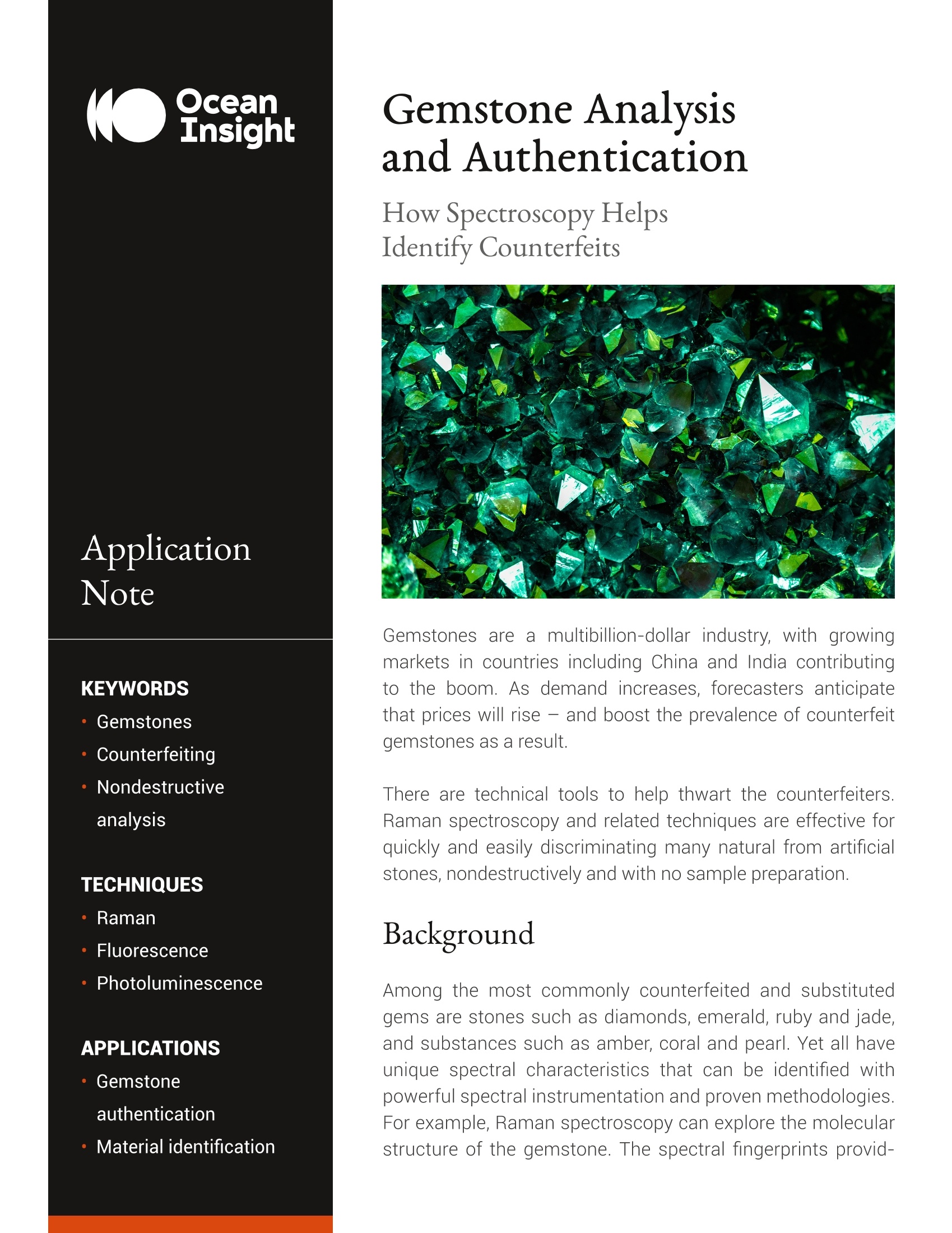
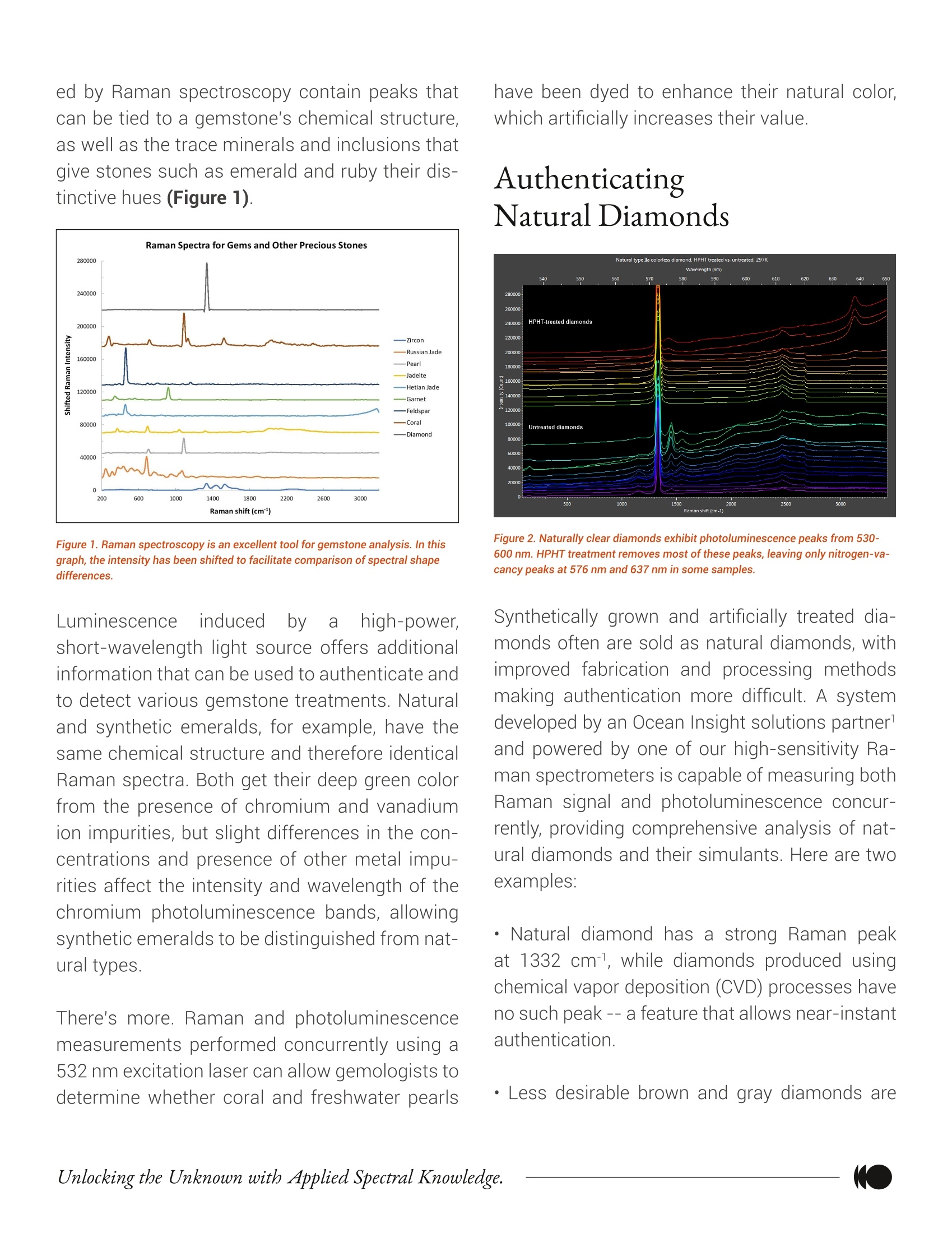
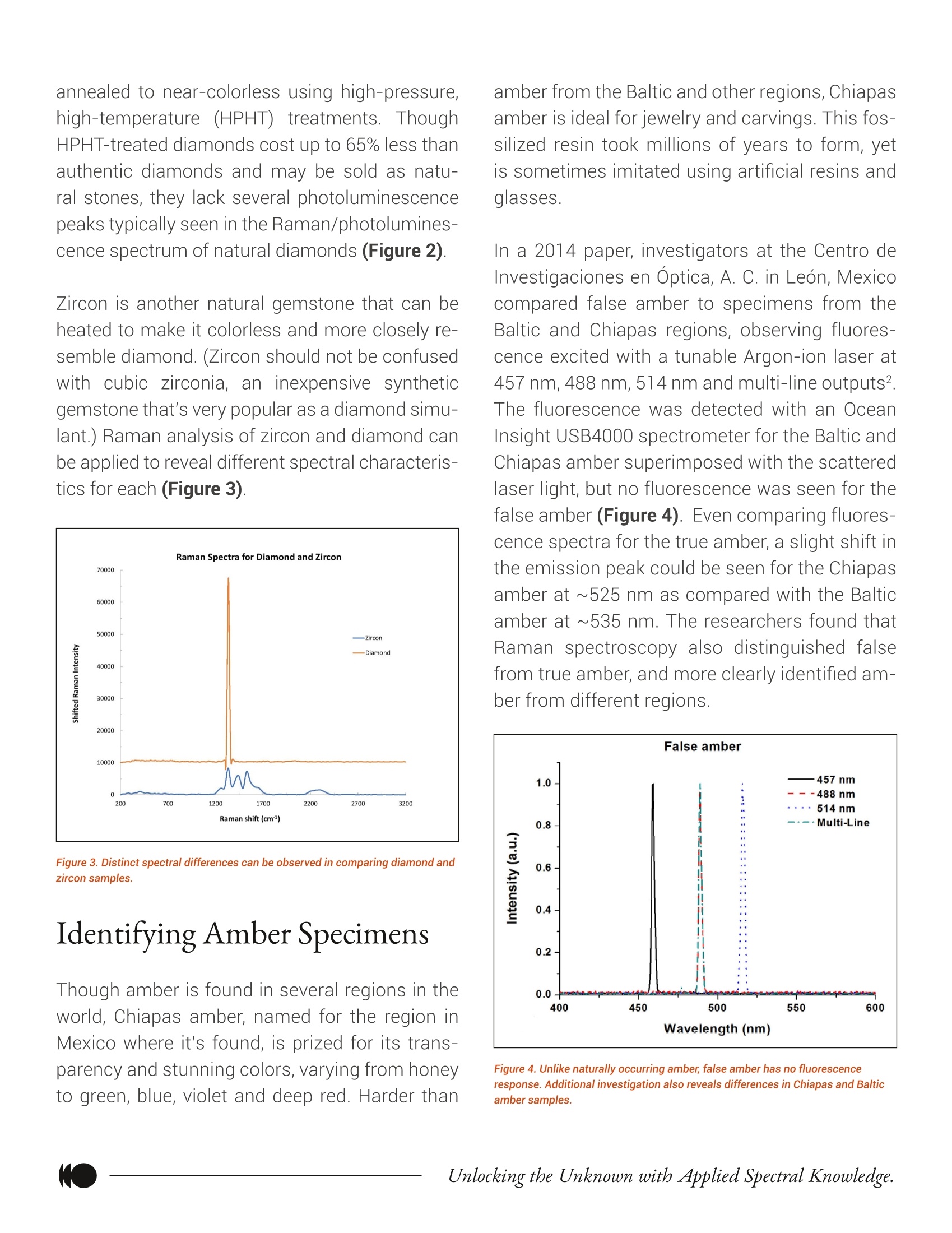
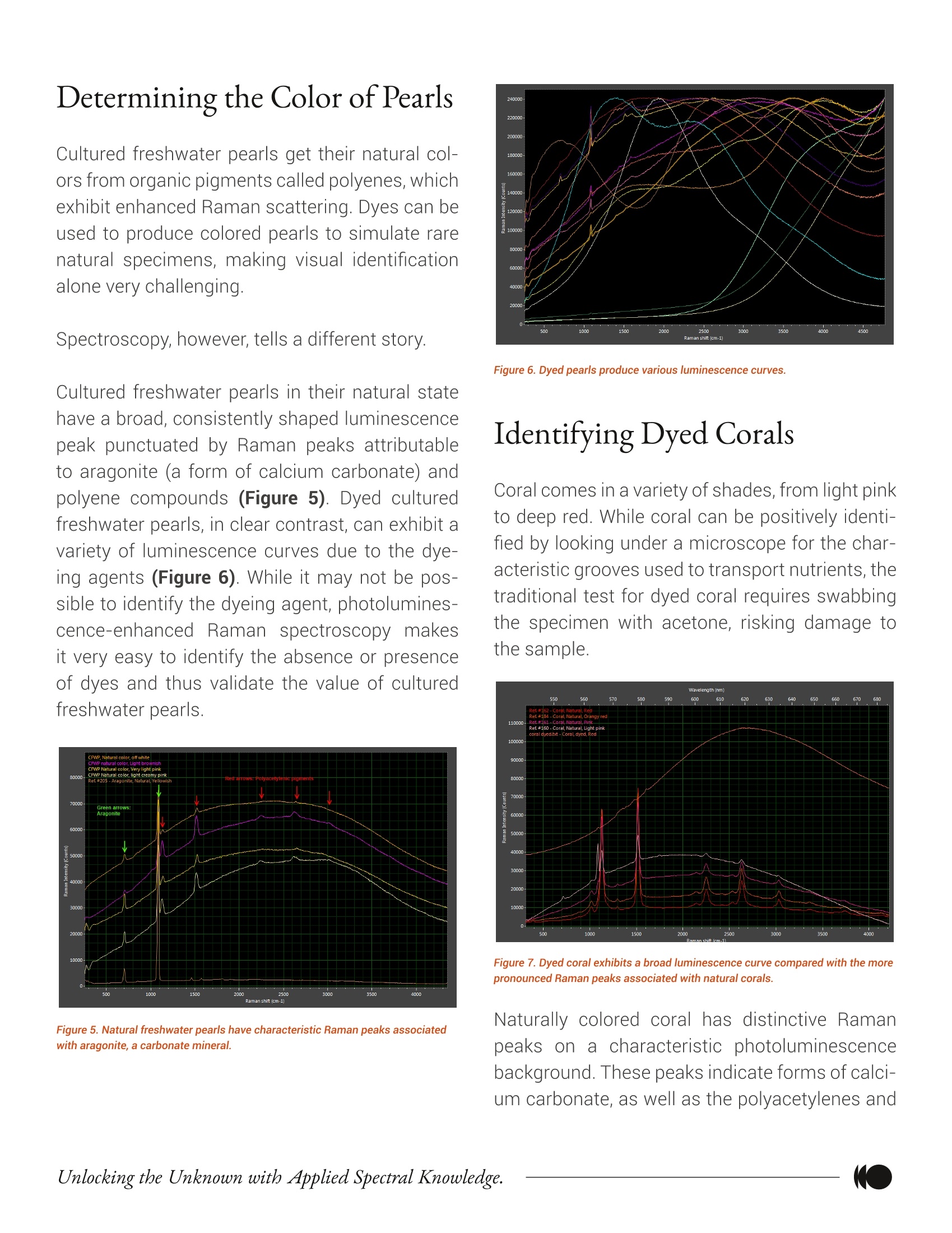
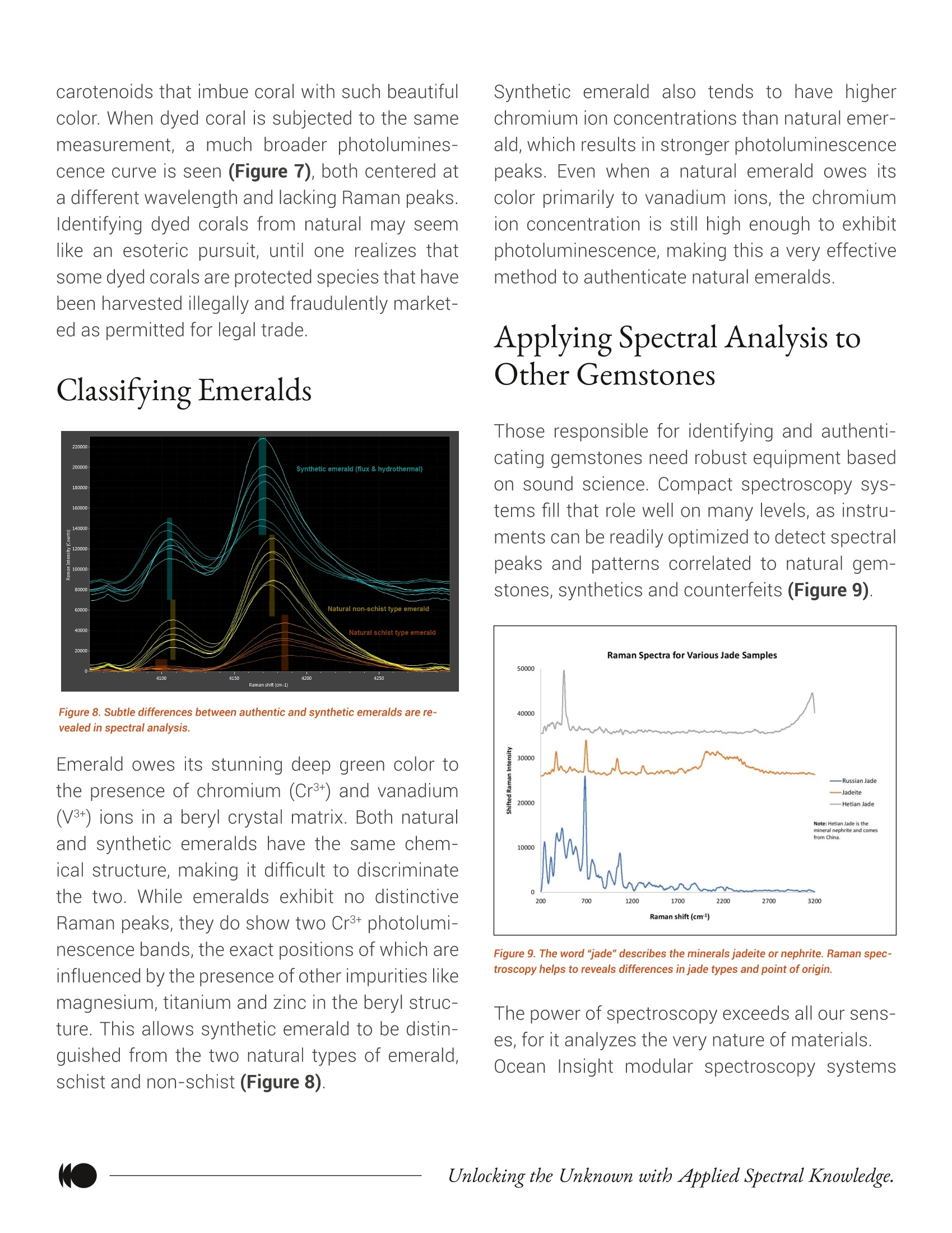

还剩4页未读,是否继续阅读?
海洋光学亚洲公司为您提供《宝石中真假检测方案(光纤光谱仪)》,该方案主要用于珠宝/玉石中真假检测,参考标准--,《宝石中真假检测方案(光纤光谱仪)》用到的仪器有光纤光谱仪海洋光学高性能QE Pro
推荐专场
相关方案
更多










